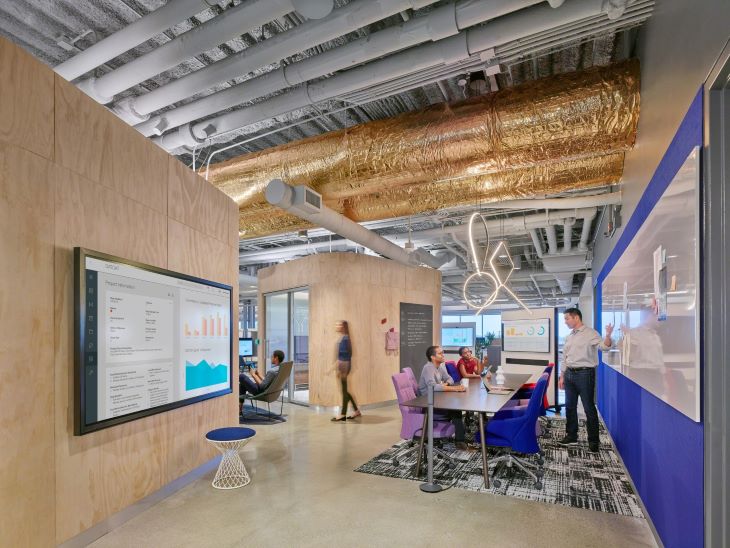Steelcase’s Dr. Tracy Brower shares the change management mistakes we’re making as an industry and how can we support the process more effectively.

You talk with your clients about it all the time—change management is critical to success and it’s an insurance policy of sorts. If you’re investing in a new space or a refreshed design, adjusting can be challenging for people—and change management can help ensure success. These things are true, of course. But there are still a fair amount of change management mistakes. So, what’s going wrong? What are the mistakes we’re making as an industry and how can we support change management more effectively? Here are the common mistakes and how to avoid them:
Assuming the change is about the space
Of course, if you’re doing a restack of a corporate headquarters or constructing a brand-new building, it can feel like the change management effort is all about the building and the space. But in reality, changes like these are always about the organizational outcomes the company wants to accomplish. Whether it’s market growth or increased shareholder value, keep your eye on the bigger picture and how the new space will contribute. The space is important and it’s a significant investment, but its role is to support greater innovation, collaboration, customer focus or the like. No company is changing space just for the sake of space. So be sure your change management efforts reinforce the business reasons for the change.
Focusing only on communication
Communication is admittedly a significant part of effective change management, but it’s just that—only a part of the whole. True change management also demands a focus on people’s emotions and their engagement as well as a focus on leadership and connections with project management processes. An approach in which we tell people what’s coming, explain what to anticipate, and instruct them about their new space can only go so far. Without the opportunity for people to process, participate and shape their future, your efforts will be just a sales job—and not an opportunity to engage both hearts and minds. Focus on behaviors, recognizing place shapes behavior, and behavior over time is culture. Change management must address the overall experience (including, but not limited to the space). It must be part of the culture—both current and desired—and it must consider the social and behavioral elements of change.
Assuming people can read a plan
When most companies change their space, they share images of the floor plan. They color code it, add call-outs, and delineate zones. Unfortunately, many people can’t read a plan—even though most would never admit this. Based on this limitation, if you’re using a plan to tell the story of spatial changes, you’ll be missing much of your audience. Better to provide multiple ways of visualizing the space from renderings and images of similar spaces to 3D fly-throughs, mockups and pilot spaces. Ask people to imagine how they’ll use the new space and in addition, the new protocols that will support their new ways of working in the space. In addition, share key messages through multiple methodologies as well. From town halls to email boxes for questions and from employee-to-employee luncheons to move-day experiences, be sure you’re covering all avenues for people to be informed and feel invited to learn and participate.

Asking questions you cannot address
For the sake of engagement and participation, many change leaders make the mistake of asking for feedback about the space that they can’t address. If you’re making broad-scale changes to a facility, it makes sense to ask for expansive ideas. But if you’re not, then don’t. It can be much more effective—and less frustrating to participants—to set a boundary for the input you want to gain. For example, if you’re not adding a fitness facility in the new building, don’t have participants go down a bunny trail of discussion around the elements of an ideal workout zone. Or if you have no intention of refreshing the work café, stay away from that area of envisioning. Asking participants for input is a wonderful way to engage them and two-way communication is key to success. But by definition, it will introduce dissatisfaction as people reflect on how much better things can be. This can be healthy if you’re making changes, but if you’re not, the process will just introduce unnecessary frustration. A good mantra to keep in mind: “Don’t ask questions you don’t want the answers to.”
Failing to leverage dissatisfaction
But don’t dismiss dissatisfaction entirely. You’re setting a compelling vision for the new space and you’re explaining how you’ll get there, but don’t forget to introduce a healthy dose of dissatisfaction with the present situation. If people don’t have a sense of a burning platform, they won’t be motivated to change. They’ll have the pull from the vision, but they won’t have the push from the present that no longer works. Introduce this dissatisfaction in a constructive way—regarding what will be changing. What you’re living with today was the best solution at the time and within constraints, but work moves faster than the workplace can, and change becomes necessary. Remember that while you may be thinking about the workplace regularly, the average employee is not, and it will be necessary to be clear about what’s not working perfectly today. Whether collaboration is hampered by too-few community areas or if innovation is sacrificed because space doesn’t support the cross-pollination of groups, these negatives can be positive motivators for change. They point to what must change to realize a more effective overall work experience.
Sugar-coating the change
Good change management shouldn’t be about spin. There are always negative aspects of change and it’s not uncommon for people to resist changes to their work environment. Workplace change can be a big investment and it can require employees to learn new methodologies, necessitating time and stretch. There are positive trade-offs of course, but be clear about these, rather than just sugar-coating the legitimate challenges that come with change. Explain the investments that will be necessary—of time, energy, funds—but also describe the positive outcomes and the ways employees will be supported through the change process with training, coaching and guidance.

Under-investing in leaders
Front line leaders are a critical part of the change process and arguably have the hardest job. They are often going through the most change themselves and they must support their people through change as well. They must find a way to be authentic and transparent at the same time they’re being professional and consistent about the company messages they’re sharing. Be sure to provide focused training for managers about how to lead through change. Give them talking points and guidance, and set up coaching pairs between leaders and their peers so they can support and coach each other.
Stopping too soon
Another mistake to avoid is assuming the change management efforts are finished when people move in. While this may seem like the finish line, it is important to continue to coach and support people in their new environment. Provide orientation to the space and refresh people’s knowledge over time (one customer we know does regular scavenger hunts to this end). Once they’re in the space, ask team members to discuss their protocols and social norms. Set up systems where people can fully activate the space and build community using the features of the new space to do so—from a “party in the park” using their new indoor garden areas to a pancake breakfast (with leaders as the chefs) in their new neighborhood café. These kinds of activities can get people to use and appreciate the new features of the space.

Measuring only the impact of the space
You’ll be measuring the impact of the space and its results on key organizational outcomes, but don’t forget to measure the success of the change efforts themselves. What strategies worked well and less well? To what extent were people engaged, oriented, and accepting of the changes based on your approaches? This kind of measurement and feedback can go a long way toward informing the next change management effort the company undertakes, even if it’s not space-related.
The most effective change management is rooted in the overall organizational outcomes you’re pursuing and the behaviors and culture you want to foster among employees. Space is a part of this. Avoid common mistakes in the process of managing change and you’ll be on your way to a space people embrace and results you desire.


Hello! Great article! I really appreciate the depth of analysis you provided on this topic. Keep up the good work!